Tuesday, April 30, 2013
Toyota i Road Concept

Toyota has revealed its Toyota i-Road Concept at the Geneva Motor Show in March.
According to Toyota, the Apple-esque named concept is a “compact, fun and emissions-free personal mobility concept, designed to offer quick and efficient urban transport for two people.”
The i-Road has a good chance of becoming a production car, under a different shape and name, which might go against the VW Up! and its Czech and Spanish brothers.



2013 Cadillac XTS
2013 Cadillac XTS As confusing as most alphanumeric car names have gotten in recent years, at least one constant has been that the letter "X" is generally indicative of a crossover. Then why did General Motors use this letter on its new 2013 Cadillac XTS luxury sedan? Well, for that, well have to look to the world of mathematics where "X" stands for an unknown variable or a placeholder. Now were talking. The XTS is just an interim product sitting at the top of Cadillacs four-door food chain until the brand gets a true flagship in place. That sounds like a lot of resources to spend on what will likely be a one-and-done model, but the automaker needed to get something – anything – to replace the DTS.
2013 Cadillac XTS
 |
| 2013 Cadillac XTS front view |
 |
| 2013 Cadillac XTS rear view |
 |
| 2013 Cadillac XTS rear 34 view |
 |
| 2013 Cadillac XTS grille |
 |
| 2013 Cadillac XTS headlight |
 |
| 2013 Cadillac XTS wheel |
 |
| 2013 Cadillac XTS badge |
 |
| 2013 Cadillac XTS interior |
 |
| 2013 Cadillac XTS front seat |
 |
| 2013 Cadillac XTS rear seats |
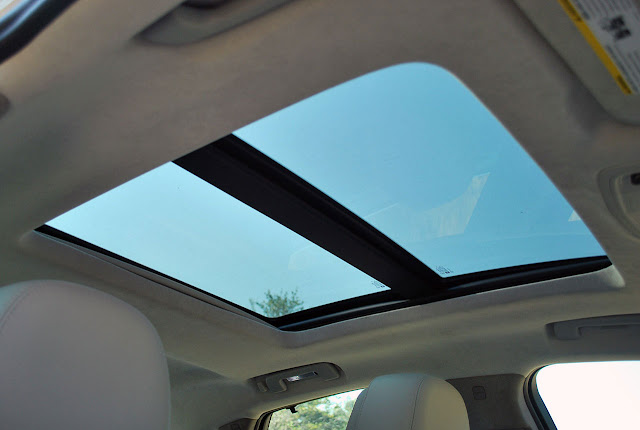 |
| 2013 Cadillac XTS sun roof |
 |
| 2013 Cadillac XTS engine |
 |
| 2013 Cadillac XTS logo |
So here you have the 2013 XTS. A big luxury sedan that was created to bridge the gap between Cadillacs recent past and its pending future. Going into our week with this XTS knowing that it was a stopgap measure proved to be both a blessing and a curse. On one hand, we know (or hope) that this car will act as a baseline for future high-end Cadillac models, but at the same time, we couldnt help but be mindful of past stopgap models, albeit in more entry-level segments, like the Cimarron and Catera.The XTS proves that GM has finally gotten platform sharing to the point where its no longer a trivial game of "spot the differences" between products from its various brands. Although the XTS shares many of its underpinnings with the Buick LaCrosse and the 2014 Chevrolet Impala, the three cars look nothing alike. Overall, the XTS – along with the ATS – shows a promising evolution of Cadillacs signature styling cues, and it looks remarkably good even on a car measuring almost 17 feet in length. From most angles, its hard to criticize the design of the XTS, but the rear three-quarter view exposes some of the cars chunkiness, which is likely a result of the long rear overhang and the short decklid. The bulky rear end does help the XTS provide a cavernous 18 cubic feet of cargo space, which happens to be almost two cubic feet (an extra piece of luggage) more than the Mercedes-Benz S-Class.
As nice as the overall styling of the XTS is, the exterior lighting might be the cars most expressive design elements. Up front, the headlights have a softer, rounder shape than previous Cadillac "Art & Science" designs, and there are also stylish lower running lights that line up perfectly with the headlights as if each side has a single light tube tucked in behind the fascia. Likewise, the vertical taillights also add to the cars appearance and even have some slight fin action that pays homage to classic Cadillacs. Perhaps the coolest exterior features on the XTS, though, are the illuminated door handles.Most versions of the XTS get features such as adaptive headlights and the parallelogram-shaped exhaust outlets integrated into the rear fascia, but our tester was the top-of-the-line XTS-4 Platinum, which included a distinctive satin-chrome grille, standard 20-inch wheels and available White Diamond Tricoat paint.Things get even better for the XTS once you look inside the car. GM has hit some pretty big milestones for interior quality over the last several years, including the 2008 Malibu and the 2010 LaCrosse, but it wouldnt be hard to argue that the XTS has one of the best-looking, highest-quality interiors GM has ever put together, and maybe even one of the best interiors found in a car priced under $100,000. Our Platinum tester had a nice mix of hues and materials, from three colors of leather used on the seats and instrument panel to the real wood, piano black and metallic accents. You cant touch anything inside this car without it being covered in some rich material, right down to the microfiber suede covering the headliner and A-pillars.
Front passengers are treated to wide, plush seats wrapped in soft perforated leather with heat and ventilating functions; youre not going to confuse the XTS seats for sport buckets, but as the theme of the car proved, its not trying to be a sport sedan. Rear seat occupants are rewarded with plenty of headroom and legroom, as well as heated bottoms for the outboard passengers and sunshades for the side and rear window. For long hauls, the back seat is definitely the place to be.Like the exterior, lighting also plays a big role inside the XTS with ambient lamps that emanate from just about everywhere at night, along with steering wheel, center stack and even rear-seat controls that illuminate only when the car is on.In addition to the comfort afforded to XTS occupants, the car also delivers the expected amount of technology in this price class. Stealing a page from the Jaguar playbook, the XTS has a massive LCD screen for the gauge cluster that offers four different layouts with numerous information screens, and for more data, our tester also had a head-up display. Another innovative technology introduced on the XTS is the Safety Alert Seat, or as we like to call it, the butt buzzer. This uses separate buzzers on each side of the seat to relay different information to the driver. While driving, if the car starts to veer out of its lane to the left, then the left side of the seat bottom will vibrate; likewise, if the driver is backing up blindly and a car is approaching from the left, then the left side will vibrate.
In many regards, you just cant beat the XTS interior, but there might be some objections to its functionality, mostly where it concerns the new CUE – Cadillac User Experience – interface and its associated technologies and controls. More than just an infotainment system, CUE is how passengers interact with the car, and like any other advanced infotainment technology (think MyFord Touch), there is definitely a learning curve to dealing with this system.Most vehicle operations can be controlled either by touch or voice, but the capacitive touch buttons and touch-screen display are sometimes slow to respond, so after youve accidentally double-clicked an option, you have to find the way to back up a step. Further creating some potential confusion, there are no hard buttons on the center stack, so the capacitive controls there have a weird "thud" feedback when operated. Keeping in mind that this is the first generation of CUE, we actually applaud Cadillac for not pigeonholing the XTS interior by leaving out high-tech features to appease former DTS clientele. Its not easy judging a system like this after having only used it for a week, but like with MyFord Touch, we bet that owners who deal with CUE on a daily basis will have far fewer problems with the interface than we did. And when frustration levels become too high, CUEs voice recognition system is actually one of the better weve used and can easily handle inputs for functions used often while driving like changing channels or finding albums to play on your smartphone.
2013 Cadillac XTS
While the styling, luxury and technology of the XTS are all top-notch, its what you cant see that prevents this car from holding a flagship status. Many luxury sedans in this size and price range get rear-wheel drive and at least offer a V8 engine, but the XTS is only offered with a direct-injected 3.6-liter V6 engine powering the front wheels through a six-speed automatic transmission. Our test car was the 4,215-pound, all-wheel-drive model, making the engines 304 horsepower and 264 pound-feet of torque feel underpowered at times. But this car isnt about speed or quickness. Its about a smooth, comfortable ride, and Cadillac nailed this aspect seeing as how the XTS will, like the DTS and STS it replaces, continue to be a popular choice among the snowbird crowd. (To properly experience this, we did our week-long test of the XTS in – you guessed it – Florida.)With names like Brembo, Haldex and Magnetic Ride Control listed on the spec sheet of our tester, we could have just as easily been testing a sporty European sedan, but as nice as the interior is, driving the XTS will quickly confirm that "sport" is not in this cars vocabulary. As advanced as GMs LFX V6 is, it feels overworked in the XTS under moderate to heavy acceleration, which didnt surprise us when our weeks worth of driving netted a combined 18.2 miles per gallon compared to the official EPA numbers of 17 city and 26 highway. If it were sportier to drive, we could live with such a number, but as a car that will likely make many a road trip from the Rust Belt to the Sunshine State, fuel economy was subpar.
On said road trips though, GMs Magnetic Ride Control shines in the XTS. The real-time, four-wheel suspension damping mixed with the rear air suspension makes this car an absolute dream to drive, absorbing potholes and road imperfections like a champ without ever feeling too soft or spongy. The Haldex all-wheel-drive system will come in handy for those aforementioned snowbirds with an electronic limited slip differential that can split up engine power at each wheel individually, but we never figured out why the XTS come standard with Brembo front brakes. We found no faults in the XTS stopping distance, but at the same time, we saw no reason for the added cost either – yes, these brakes are standard on all cars, but replacement Brembo pads are never cheap. The only other grumble we could muster about the driving dynamic of the XTS was the choice to stick with a conventional hydraulic steering system rather than going to a smoother, more efficient electric system, especially for lower speed turns where the steering could feel a little jerky at times. As many small gripes that we had with the car, however, theres no question that the XTS is a V8 and nine-speed automatic transmission from being a true game-changer for Cadillac, even with its front-wheel-drive platform.Another downside of the XTS is its price, even though the base models $44,075 MSRP isnt where the sticker shock lies. Its when you start tacking on options and packages that things get out of control. Our all-wheel-drive Platinum Collection tester topped out at $62,300, which, for that kind of money, is priced dangerously close to sportier, albeit smaller, sedans like the Jaguar XF and Lexus GS. Buyers looking for luxury and the latest technology, however, will likely not make the mistake of associating the XTS with those similarly priced sport sedans. Considering its chassis and driving dynamics, its still playing in the mid-luxury sandbox with the likes of the Lincoln MKS, Volvo S80 and Lexus ES.
2013 Cadillac XTS
What youre getting for that as-tested price is a fully loaded sedan that finally gives Cadillac some momentum to swing back into the luxury car fight. Once the world standard for luxury and quality, Cadillac got there using vehicles with revered names such as Fleetwood, Deville and ElDorado, but today the way back to relevance starts with a vehicle given an anonymous, place-holding name: XTS. Its the Cadillac of stopgaps.
Volkswagen golf mk1
Having scored much immense round success with the Hammer, Volkswagen then harassed its rivals by continuance the similar fox with its minute hatchback Sport. This Giugiaro-designed work was just the parcel car at the hand example, but it was in GTI var., from 1975, that it was most stately. The car that invented the statue hot hatch utilized a Bosch fuel-injected 1588cc engine to viscus 110bhp finished its forepart wheels and the skintight and nimble handling meant all this could be misused to the max. A 1781cc engine and type headlamps asterisked out 1982s 1800 assistant.
Download here
Labels:
golf,
mk1,
volkswagen
2012 Chevrolet Tahoe Hybrid Review
 |
| Chevrolet Tahoe Hybrid |
New for model year 2012. Standard electronic stability system Tahoe Hybrid is equipped with electronic control of the trailer and Hill Start Assist. A stereo with 30-gigabyte hard drive, navigation, 7-inch touch screen, recording capabilities and a standard USB port and side airbags for the front seats.
Viewed from the outside, the Tahoe Hybrid is very similar to a Tahoe regular SUV , meaning that relatively square. However, there are some subtle between the two.
Standard equipment includes 18-inch wheels, alloy wheels, automatic headlights, rear parking sensors, running boards, power heated folding mirrors, remote start, cruise control, three-zone automatic air conditioning, power adjustable pedals, rearview auto-dimming mirrors, heated six-way power front seats, a row 60/40-split-folding second, 50/50 folding third-row seats removed, and skin in the first two lines.
Inside the Chevrolet Tahoe Hybrid 2012 is almost identical to that found in the design without the usual meaning of Tahoe, but attractive and fit and finish strong. The only significant difference is a panel with information dedicated to the hybrid operation. Specific information, such as energy flow and the hybrid battery status is displayed on a touch-screen navigation are associated with defects. The buttons and switches simple and intuitive operation, but the buttons and the touch screen on the small side compared to similar systems offered elsewhere.
Chevy Tahoe Hybrid has a 6.0 liter V8 engine. By itself, the power of a V8 of 332 horsepower and 367 lb.-ft. of torque. With two 60 kW electric motors are powered by nickel-metal hydride rechargeable battery in the back seat. GM engineers say that the strength of the combined gas and electric motors is 379 horsepower.
The first mode Tahoe hybrid system for transferring power grid or just a combination of both are designed for city driving lights loads. The second, usually road mode provides power to help the V-8.
The 2012 Chevy Tahoe Hybrid is equipped with ABS disc brakes, stability control, traction control, front side airbags, curtain airbags, rear parking sensors and OnStar emergency communications.
Insurance Institute for Highway Safety has not crash tested the 2012 Chevrolet Tahoe Hybrid, but thats because it is usually not to test a large SUV or luxury vehicle. The federal government has been successful. Tahoe hybrid won five of five stars in frontal crash tests and side, and three out of five stars in rollover tests, to score a total of four out of five stars.
Mechanically identical GM models like the GMC Yukon Hybrid and the Cadillac Escalade Hybrid have gas and electricity, full-size SUV competitors of the Tahoe Hybrid. However, they are willing to spend more money to choose a more luxurious ride a little smaller, more efficient, such as the BMW X5 diesel variants.
The Tahoe Hybrid fuel economy should be compared with other companies to large families, especially in the city. If this is your first priority, while maintaining maximum function, and then the 2012 Chevy Tahoe Hybrid is actually only show in town. However, they also save money? That seems very questionable.
How to Bleed a Radiator on a 2003 BMW 325i
1. Park your car on level ground and allow its engine to cool for at least three to five hours.
2. Jack the car up and place it on axle stands.
3. Disconnect the negative cable from the battery.
4. Remove the cap from the top of the radiator.
5. Place the drain pan underneath the blue plastic drain plug, found at the bottom of the radiator. Remove the plug with a wrench or spanner.
6. Drain the fluid until it stops. If it contains any debris or metal flakes, you will need a professional to inspect your radiator.
7. Drain the coolant into a bottle, seal it, and dispose of it at an appropriate recycling facility.
8. Inspect the radiator cap for dry rot or wear and tear. Replace it with a new cap if necessary.
9. Flush cold water through the radiator.
10. Fill the radiator with water to help remove the remaining antifreeze.
11. Replace the radiator cap and turn on the engine for five minutes.
12. Turn off the engine and allow it to cool.
13. Repeat steps 3 to 6 until the water is clear.
14. Pour the flushing agent into your radiator. Repeat steps 11 and 12, and then drain the flushing agent.
15. Replace the plug once all of the coolant is emptied out of the radiator. Tighten to 2 to 3 Nm (18 to 27 inch pounds).
16. Remove the small plastic bleed screw to the right of the radiator cap. Using a large funnel in the expansion tank, slowly fill the car with new liquid--50 percent coolant, 50 percent distilled water. Restart the car engine for five minutes to open the thermostat.
17. Add more antifreeze or coolant until the radiator is full. Screw the cap back on the radiator.
18. Bleed the air out of the expansion tank on the side of the radiator. Otherwise you will have a separate, external expansion tank which is self-bleeding. With the bleed screw removed, fill the expansion tank until fluid begins coming out of the bleed screw.
19. Run the engine until it reaches its operating temperature. Turn off the engine and let it cool down. Top up the coolant in the expansion tank to the appropriate level, if necessary.
Toyota Yaris Hbyrid 2012
Toyota Hybrid 2012
This time, toyota issued a car with hybrid technology with the most extraordinary performance
for spesification
The latest generation of machines 1.500cc with VVT-i technology (Variable Valve Timing with Intelligent) capable of reaching 109 PS maximum power when engine speed reaches 6,000 rpm and maximum torque 14.5 kgm at 4,200 rpm engine speed, the young riders will meet the desires of the vehicle with excellent performance, great power and torque but efficient in fuel consumption.
 |
| Toyota Yaris Hbyrid 2012 Front |
 |
| Toyota Yaris Hbyrid 2012 Cokpit |
 |
| Toyota Yaris Hbyrid 2012 |
 |
| Toyota Yaris Hbyrid 2012 Left Views |
Super ECT (Electronic Controlled Transmission)
With technology Super ECT (Electronic Controlled Transmission) is not going to happen the beat - the beat of a surprise at the turn of the automatic transmission in the Yaris. This technology will make the changes smoother transmission and reduce the frequency of transmission changes as it passes through the road climbing or descending.
LA 2010 Saab 9 4X【Video】
Saab Automobile makes the headlines at this year’s Los Angles Auto Show by launching the 9-4X, its first crossover vehicle, and showing its 9-3 ePower, the prototype for a fleet of all-electric test vehicles.
While the 9-4Xs styling is clearly the evolution of Saabs Aero X concept, the Cadillac SRX provides much of the crossovers underpinnings. It was developed during GMs ownership of Saab. That means the 9-4X gets the GM Cadillacs 198kW 3.0-litre V6 or Australian-made 224kW turbocharged 2.8-litre V6, both mated to a six-speed automatic.
Inside, the cabin comes nicely equipped with leather upholstery, eight-way power seats, wood trim (faux carbon fiber in the Aero), mesh-style air vents, and a center console-mounted push-button ignition. Saab also offers a Bose audio system, GPS navigation (with an eight-inch touchscreen), tri-zone climate control, and a rear entertainment system.
Available in three trims, the 9-4X base model is powered by a 265-horsepower, 3-liter V-6 and will cost about $38,000. An all-wheel-drive version is also available using the same powertrain. The top-of-the-line 9-4X Aero, pictured above, employs a turbocharged 2.8-liter V-6 that cranks 300 horsepower and will cost about $50,000.
Source: Saab

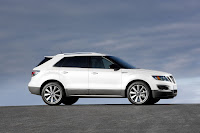
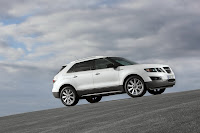
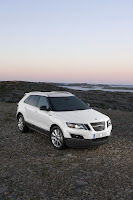



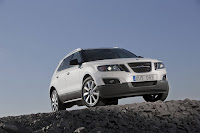


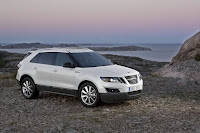
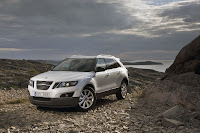
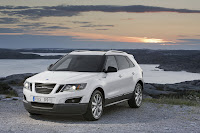
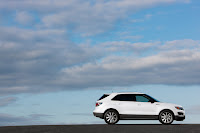


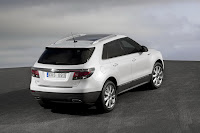




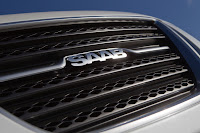
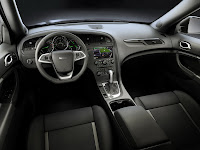

Press Release
New Saab 9-4X: World Premiere. Scandinavian Choice for the Crossover Segment
- Saab enters growing crossover segment
- Progressive Scandinavian design inspired by Aero X concept
- Car-like driving dynamics challenge best-in-class performance
- Advanced Saab XWD mated with Saab DriveSense adaptive chassis
- Spacious cabin, driver-focused cockpit and ample storage
- Compact, light, efficient engines: 265 hp 3.0V6i and 300 hp 2.8V6 turbo
- Flexible cargo management system
The new 9-4X brings unique Saab design and engineering values to the growing mid-size crossover segment. With distinctive Scandinavian and aircraft-inspired looks, it also offers car-like handling and ride characteristics that challenge class benchmarks.
Making its world premiere at next months Los Angles Auto Show, the 9-4X expands Saabs product portfolio to three car lines and will provide a fresh, alternative choice for independently-minded crossover buyers. It is an important next-step in the Swedish brands renaissance as an independent premium car manufacturer.
Muscular and sporty to drive, the 9-4X is aligned in looks and size between the 9-3X all-rounder and new 9-5 sedan. Outside and inside, it communicates its Saab identity with clean, uncluttered design and signature motifs, such as its wraparound-effect windshield, ice block lighting theme, driver-focused cockpit and flexible cargo handling.
In true Saab tradition, the 9-4X delivers on its sporty persona. It is configured around a unique, purpose-designed crossover body structure, which has been key to delivering its exceptional handling and ride properties. Car-like driving dynamics are supported by Saabs advanced all-wheel-drive system, Saab XWD, and DriveSense adaptive chassis control.
Under the hood, nestles a choice of compact and efficient V6 engines, naturally-aspirated or turbocharged. The 265 hp, 3.0-liter motor for the entry-level model features direct fuel injection and variable valve timing; while the 300 hp, 2.8-liter exchanges direct injection for twin-scroll turbocharging and is exclusive to top-of-line Aero variants. Both engines are mated to six-speed automatic transmissions under adaptive, electronic control.
"The 9-4X significantly broadens the appeal of the Saab brand," says Saab Automobile CEO Jan Åke Jonsson. "It gives us entry to the fast-growing crossover segment with a vehicle that reflects our brand values in key areas, such as progressive Scandinavian design and sporty, responsible driving performance. The 9-4X is an exciting package and were confident it will appeal to many existing Saab owners, as well as win new customers for the brand."
The 9-4X goes on sale in North America in May next year, with sales in Europe and other global markets due to begin from August. Prices will be announced shortly before sales commence.
Body sculpted by Saab
The 9-4X cuts a broad and powerful stance, with clean, uncluttered lines that echo Saabs Scandinavian design ethos. Its distinctive face, in common with the new 9-5 sedan, draws inspiration from the award-winning Aero X concept car, with a deep, three-port grille and ‘ice-block-effect lighting themes.
Disguised windshield and door pillars create Saabs signature wraparound-effect, the single glasshouse graphic emphasizing the brands traditional ‘cockpit look. Other exterior Saab identifiers include the shaping of the headlamps, a ‘hockey stick waistline and strong C-pillars complemented by a wraparound-effect rear screen.
The roofline is visually lowered and extended by a rear spoiler integrated in to the tailgate. At the rear, the lighting carries forward a signature introduced by the new 9-5 sedan. An ‘ice-block bar lit by LEDs extends across the lower tailgate and wraps around the light units. Twin rhomboid-shaped exhaust tailpipes are also neatly integrated into the lower bumper molding.
Overall, the 9-4Xs bodywork is noticeably free from unnecessary decoration or trim. A dark protective appliqué is applied to the lower body, but there are no wheel-arch claddings or protective body panels.
Entry-level variants are fitted with 18-inch, six-spoke alloy wheels and Aero models are distinguished by 20-inch, nine-spoke turbine alloy wheels, as well as a black mesh front grille.
Cockpit-inspired cabin
The spacious cabin provides comfortable accommodation for up to five adults and is defined by a signature Saab, driver-focused cockpit layout. The center console, center stack and main instrument display are presented within a single form that sweeps up around the driver. For the 9-4X, this is finished with wood or, for Aero interiors, a carbon fiber-effect trim.
Other subtle references to Saabs aviation heritage include a selectable, aircraft attitude-style speed read-out, green illumination for the needles of the three main dials and traditional Saab ‘joystick adjusters for the mesh-style air vents. The ignition - a start/stop button - is, of course, located between the front seats, in true Saab tradition, adjacent to the shift lever.
Large, supportive seats include a standard, 8-way electrical adjustment for the driver and an optional electrical adjustment of the foot pedals. Rear passengers enjoy particularly roomy accommodation as rear space is not compromised by the presence of a third row of seats. They also benefit from an independent, three-way manual adjustment of the rake of each 60/40 fold seatback.
Ample onboard storage includes double-decked pockets in all doors, a two-tier front glovebox and a deep bin in the center console with 12-volt, USB and AUX connections. Rear passengers have additional storage in the rear face of the center console and the center armrest.
Infotainment includes two audio options, a seven-speaker or top-of-the-line, 10-speaker Bose system with 5.1 surround sound. The optional 8-inch touchscreen, hard disk-based navigation system includes a birds eye map view and 10 GB storage for ‘jukebox music files. Communication on the move is supported by an integrated Bluetooth hands-free phone system, which functions via voice command and steering wheel controls, as well as the infotainment panel.
In the rear, passengers can enjoy independent climate control, in addition to the standard dual-zone system, and select their own onboard audio/visual entertainment through a dedicated unit in the back of the center console. This has a video AUX input and two 8-inch screens in the rear face of the front seatbacks.
Adaptable cargo carrying
The trunk of the 9-4X is optimized for space and ease of use. The 60/40 split seatbacks fold down in a single movement, without having to move the seat cushions or remove the retractable head restraints, providing a completely flat cargo deck.
The front section of the trunk floor is hinged and can be opened via an aircraft-shaped handle to reveal an additional under floor storage. Floor space can be tailored as required by an optional, U-shaped track with a telescopic cargo dividing rail, which can be moved to any position to keep items in place.
For additional convenience, the tailgate is available with a remotely controlled, hydraulically powered operation. It can open fully, or to a lower, programmable position if there is restricted clearance overhead, such as in the garage.
On the move
The Saab 9-4X brings car-like handling and ride qualities to the crossover segment. Extensive development testing alongside competitor vehicles shows the 9-4X has a level of dynamic performance - in ride refinement as well as handling - that challenges the very best in its class..
Key to such excellent driving qualities is a unique body structure, purpose-designed for a crossover application and free from compromises through adapting an existing sedan or wagon format.
Advanced driving technologies include Saab XWD, the sophisticated all-wheel-drive system, which infinitely varies drive torque between the front and rear axles. This pre-emptive, light and fast-acting system offers optimized grip in all conditions, dry or wet, smooth or loose, on road or off-road. It is combined with an electronically-controlled, rear limited-slip differential (eLSD) which can transfer up to 50% of rear torque between the rear wheels, to whichever has more grip
Driver and vehicle in the Aero are brought even closer together by Saab DriveSense, an adaptive chassis function which uses real time damping control to help the 9-4X react to how it is being driven and to changing road conditions. In addition to the default ‘Intelligent setting, the driver can select ‘Comfort and ‘Sport modes. An ‘Eco mode, activated via a separate button, also re-maps the throttle pedal and gearshifting patterns for optimal fuel economy.
Other driving aids include variable effort steering, a function of Saab DriveSense, and standard bi-xenon adaptive lighting, which provides better illumination of upcoming bends by linking the direction of the headlamp beam to the steering angle.
Efficient power packs
The powertrain line-up comprises two efficient all-aluminum V6 engines, both with a six-speed automatic transmission and Saab XWD. These light and compact, 24-valve motors feature variable valve timing, on both inlet and exhaust sides, and boast power ratings typical of larger displacement engines.
A 265 hp (195 kW), 3.0-liter naturally-aspirated motor for the entry-level specification includes direct fuel injection. It propels the 9-4X from zero to 100 km/h in just 9.0 seconds.
Available exclusively in Aero specification, the 2.8-liter turbo engine packs 300 hp (221 kW) and generates an impressive 400 Nm spread of torque between 2,000 and 5,000 rpm. It delivers zero to 100 km/h acceleration in 8.3 seconds. Fuel consumption figures for both engines are still being finalised.
Leading safety performance
Excellent safety complements strong performance, and the 9-4X benefits from more than 50 years of Saab experience in working with occupant protection. Saab crash testing and computer simulations are based on what happens in real collisions, on real roads. Many in-house tests developed by Saab are over and above those legally required or carried out by consumer test organizations.
The success of Saabs work is reflected in surveys of real-life collisions by the US Highway Loss Data Institute (HLDI) and the Swedish Folksam insurance company, where Saab cars have consistently scored well, several times being ranked best in their segment. The Saab 9-3 and the new 9-5 sedan are also maximum 5-star performers in EuroNCAP crash safety tests.
How to Reset the Maintenance Alert on a Mercedes C230
1. Insert the key into the ignition. Turn the key to the first position. Press the Menu button until the mileage display appears on the information center.
2. Press and release the Reset button three times.
3. Turn the ignition key to the second position. Press and release the lower Display button and confirm that the service interval appears on the information center.
4. Press the Reset button once. Use the + or - buttons to highlight and select the proper oil weight for the oil in your car.
5. Press and release the top Display button. Press and hold Reset for at least three seconds. Press the top Display button until the mileage reading appears. Turn the key back to the OFF position.
2011 Chrysler 200 Convertible
"The new Chrysler 200 Convertible benefits from the recently introduced, re-engineered 200 sedan," said Ben Winter, Vehicle Line Executive - Chrysler Group LLC. "We applied the same principles we used with the sedan to re-engineer the 200 Convertible. The result is the new Chrysler 200 Convertible, a car that delivers a fun, refined, responsive driving experience with ample interior space and a style unmatched in the segment."
Chrysler introduces the new 2011 Chrysler 200 Convertible, offering consumers an open-air driving experience featuring elegant craftsmanship inside and out, a fun, yet refined driving experience, innovative technology, an abundance of standard safety features and an extraordinary level of standard content. The 2011 Chrysler 200 Convertible is an exciting alternative for customers who want the benefits of a coupe and the true open-air freedom of a convertible, all at a surprising value.
Redesigned and re-engineered for 2011, the Chrysler 200 Convertible is unique in the standard specialty segment as a true mid-sized convertible that comfortably seats 4 adults and has enough room in the trunk, even when the power top is dropped. Consumers can choose from two automatically latching tops, a body-color painted steel, retractable hard top, or a cloth soft top, both of which can drop with the press of a button on the key fob.
With a new exterior design, refined ride and handling characteristics complements of an upgraded suspension, an efficient new powertrain, safety features that are all standard on every model, and a beautifully crafted all-new interior, the 200 Convertible stands alone in the segment for customers who crave the wind in their hair and sun on their face.
"The sky is the limit with the new Chrysler 200 Convertible, delivering customers stylish design with purpose and the most interior space in the segment, comfortably seating four adults and providing ample cargo space in the trunk, even when the top is down," said Olivier Francois, CEO - Chrysler Brand, Chrysler Group LLC. "The new 200 Convertible offers superb driving dynamics, a new exterior design, an all-new, beautifully-crafted interior and an abundance of standard features."
The 2011 200 Convertible is a 2-door, 4-passenger convertible, available in 3 trims, ranging from the Touring to the S.
Upon introduction, the Touring is equipped with a standard 2.4-liter, I4, 173-horsepower engine that achieves 18-mpg in the city and 29-mpg on the highway. The S is equipped with a standard 3.6-liter, V6, 283-horsepower, flexible fuel engine that achieves 19-mpg in the city and 29-mpg on the highway. A 6-speed automatic transmission with overdrive is standard on both trims.
The 2011 200 Convertible is restyled for 2011.
2011 Chrysler 200 Convertible: A drop-top do-over - Sympatico.ca Autos Chrysler rightly sends the Sebring sailing, replacing it with a much improved four-seater for sun worshippers.
New 2011 Chrysler 200 Convertible Showcases Sophisticated Style ... New 2011 Chrysler 200 Convertible Showcases Sophisticated Style, Comfort, Safety And Value With Top-down Fun
2011 Chrysler 200 Convertible Review: Car Reviews 2011 Chrysler 200 Convertible Review: Comprehensive 2011 Chrysler 200 Convertible
More significant than the exterior modifications are changes inside, where money has been thrown at everything customers see and touch. The new dash topper is nearly seamless and soft to the touch, the same for which can be said of the door panels.
Unfortunately, there wasnt enough money to update the audio head unit. Its small knobs and comparatively rudimentary interface is well behind the curve. The same goes for the Mercedes-Benz-owns-Chrysler-era gated shifter. Some years ago, we can imagine German managers pressuring Chrysler to use the design that was once the standard of the Three-Pointed Star. While you get used to it, its action leaves a little to be desired.
Regardless of the roads, it was easy to feel the changes made to the chassis. The suspension responds immediately to inputs. The wider tires bite tenaciously and the 200 tracks true. Unfortunately, while the hydraulic rack-and-pinion steering is nicely weighted, it communicates absolutely nothing about the road surface or what the tires are doing. The steering wheel might as well be a rheostat.
Since Chrysler engineers were working to improve what they had, as opposed to starting from scratch, the 200 Convertibles body structure simply isnt as stiff as some newer convertibles weve driven. When the top was down, there were minor vibrations coming through the steering column. Big bumps made the aft sections of the long doors move against their strikers. Nothing rattled, but those telltale motions dont bode well for a rattle-free long-term ownership experience.
Top down, the front seats could have been marked a buffet-free zone. Conversation at highway speeds was easy compared to many open-air rides. Our car was also fitted with a folding wind-blocker, a Mopar accessory. In the raised position, it cut the wind buffeting to almost nothing, and with the insulated hard-top in place, the interior was fixed-roof quiet.
Labels:
200,
2011,
chrysler,
convertible
Subscribe to:
Comments (Atom)




